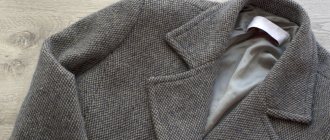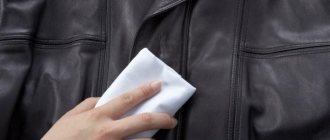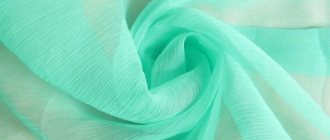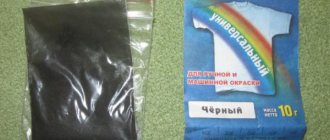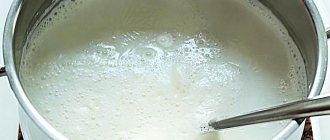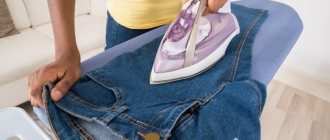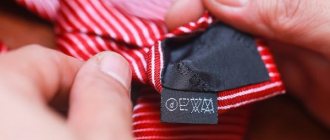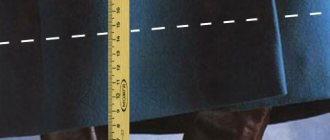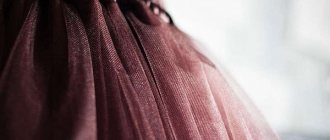Today we will figure out how to iron a coat at home, how to do it without damaging an expensive item that requires delicate care. The first thing you should find out is what fabric the product is made from. Based on the type of matter, a further algorithm of actions will be developed. There are also general recommendations, including those related to washing, the observance of which will make ironing much easier. We will tell you how to iron a coat at home and give you a lot of useful tips - study the material carefully!
What fabrics are coats made from?
A coat is a stylish and elegant element of an outer wardrobe. Modern fashion has learned to combine it with business, casual, and even sports style. Products are sold in a variety of price segments - both in luxury boutiques and in so-called “mass market” stores. Of course, the cost is affected not only by the brand, but also by the fabric from which the coat is made.
The most expensive products are made from natural wool, simpler models are made from a combined thread (wool + synthetic), and completely synthetic items are also available for sale.
To understand whether your coat can be ironed, determine the composition of its material. Let's list what fabrics these products are made from:
- Polyester. Practical, inexpensive material that practically does not wrinkle. These coats are very common because they look beautiful and keep you warm in bad weather.
- Wool. It is difficult to iron a natural wool coat at home - you will have to act very carefully. For example, delicate cashmere should only be ironed when it is completely dry, but thick drape is best simply steamed;
- It is not recommended to iron suede, leather, velor or corduroy at home. It is better to take these items to dry cleaning, where professional fairies will quickly handle the task. If you still decide to try ironing yourself, use a vertical steamer or set the iron to the minimum temperature and lay down gauze folded in 2-3 layers;
- Gabardine. Thin demi-season coats are usually made from it, which are easy to iron. The most important thing is to follow the recommendations;
Nuances of care
In conclusion, here are some tips to help you care for coats made from different types of fabric:
- Always store wool coats, especially those made from alpaca and cashmere, on hangers at home. Do not throw other things on it and even when visiting, ask for a separate hanger.
- Do not wear handbags with a long strap along with an alpaca coat to avoid creases and bald patches.
- Carefully straighten your drape coat before storing so that there are no creases on the hem, sleeves, or collar. This material is quite rough and therefore will be very difficult to smooth out.
And don’t forget that proper care of your favorite things will definitely extend their service life, and save you nerves and finances.
';document.body.appendChild(d);document.pnctLoadStarted=(new%20Date()).getTime();document.pnctCnclLoad=function(){document.pnctLoadStarted=0;pl=document.getElementById('pnctPreloader' );if(pl)pl.parentNode.removeChild(pl)};document.getElementById('pnctCancelBtn').addEventListener('click',function(e){e.preventDefault();document.pnctCnclLoad()}); setTimeout(function(){var%20st=document.pnctLoadStarted;if(st>0&&((new%20Date()).getTime()-st>=14000)){document.pnctCnclLoad();alert('%3C %3F%3DYii%3A%3At%28%22uniprogy%22%2C+%22Unfortunately%2C+the+image+search+is+not+available.%22%29%3F%3E')}},15000);var %20e=document.createElement('script');e.setAttribute('type','text/javascript');e.setAttribute('charset','UTF-8′);e.setAttribute('src', '//postila.ru/post.js?ver=1&m=b&rnd='+Math.random()*99999999);document.body.appendChild(e)})());">
How can you tell what your coat is made of?
So, in order to iron a coat at home, you need to determine what material it is made of. If you don’t know how to distinguish wool from synthetics by eye, first, study the labels on the reverse side of the product. There must be information about the composition there.
However, many people doubt the honesty of manufacturers and do not trust the label. For example, pure cashmere is difficult to distinguish from linen with a slight addition of synthetic thread. At home, try the following:
- Rub the material thoroughly. If static electricity appears or sparks fly, you have synthetic in your hands;
- Examine the fabric. On synthetic fabric, pellets quickly form; on woolen fabric, they almost never occur;
- Synthetics are cold to the touch, and wool warms the palm within 5 minutes;
- Rub the material - synthetic fabric rustles or creaks, while woolen fabric does not make a sound;
- The last resort is to set fire to the thread. Natural thread does not melt and when burned it smells like burnt hair.
General ironing recommendations
Check out the general rules that must be applied when trying to iron a coat at home:
- First of all, study the ironing recommendations on the product label;
- Before you start ironing the main fabric, test the fabric's reaction to heat somewhere inconspicuous;
- It is better to iron thin items without fillers from the wrong side;
- Start ironing from the back, then move on to the sleeves, front panels and collar;
- If you have a vertical steamer at home, use it.
Technical alternative
In order not to use an iron, without excluding the use of technical means, you can “cheat” a little. There are similar devices that work differently. These are steamers, steam generators and similar household appliances.
Steamer
This is the name of an electrical device that allows you to produce steam from water. The working fluid is fed into the steam chamber in portions, then gets onto the clothes. They can be vertical, universal in design or manual. The disadvantage of a steamer is that it cannot completely replace an iron - it will only straighten out wrinkles.
Steam generator
The principle of operation of a steam generator is similar to a steamer, differing from it only in performance. The significant dimensions and weight of the device do not allow you to take it with you on a trip. More often these are stationary units, sometimes they are used in professional studios or shops.
How to iron something made from different materials
We moved on to the most important part of the article, to instructions on how to iron a coat without a steamer at home. Let's start with algorithms for products made from natural wool.
Wool coat
It is difficult to smooth out well-dried wool if the material is thick. Products made from fine cashmere, on the contrary, should not be ironed when wet. If the item does not have a lining, it needs to be ironed from the wrong side. From the front at home, iron only through gauze.
To iron a cashmere coat at home, proceed as follows:
- Set the iron to “wool” mode;
- Spread it out and place double gauze on top;
- The gauze can be lightly sprayed with water from a spray bottle;
- Next, the product needs to be ironed, observing the sequence of actions;
- Heavily wrinkled clothes are first ironed from the inside out, then again from the front side;
- It is easier to iron sleeves using a sleeve holder. Instead, you can use a rolled towel;
- Lastly, use the tip of the iron to iron the seams.
If you want to iron a drape coat, the process will look like this:
- Turn it inside out, lay it out on an ironing board or table;
- Wet well with a spray bottle;
- Set the iron to “Wool” mode and turn the wheel to “1”;
- Now try to iron the entire canvas, including hard-to-reach places;
- Iron lapels, collars, cuffs and other facial areas only through gauze;
- When finished, turn the product right side out. Turn on the steam mode on the iron and go over the entire surface without touching the fabric;
- Allow the product to cool and hang.
Well, now you know how to iron a natural wool coat at home. The same instructions should be followed if the thread contains a small amount of synthetics.
How to iron a polyester item
If you have a canvas made entirely of polyester, the process will be simpler:
- Clothes are turned inside out;
- Place gauze folded in 3 layers or thin cotton cloth on top and sprinkle with water;
- The iron is set to “Silk” mode;
- Check the tissue's response to heat. If everything is in order, the coat should be ironed completely over the entire surface.
Please note that synthetic fabric is afraid of high temperatures, so if you feel that in the selected mode the iron does not glide well over the fabric, lower the temperature or, if it is already set to the minimum, unplug the plug from the socket.
Products made from gabardine can be ironed at home using the same instructions.
Operating procedure
The order (sequence) of work when ironing a coat made of any material can be presented in the form of a step-by-step guide. The ironing process will vary depending on the device you choose.
Iron
For most coat styles, the ironing plan will look something like this:
Turn the crumpled coat inside out. Open the lining at the bottom of the garment, thereby providing access to the main material of the coat. If the lining is not sewn tightly at the bottom, then you can omit this step. Do not rip off the lining of coats made of Bolognese fabrics and outerwear made of light fabrics. Remember that the torn lining will need to be sewn back in its original place after ironing! Lay your coat out on a table or ironing board. Iron the burlap of the pockets and other small parts inside the product well. Prepare the fabric for the backing. Its length should be sufficient to fold several times. In this case, the multi-layer cut should cover at least a third of the back. This step can be omitted for those who will be ironing coats made of fabric that is not prone to sticking to the soleplate of the iron. Smooth the shoulder seams through the backing, maintaining the original direction of the cuts. Stretch the sleeves, following the folds, onto the sleeve ironer, iron the inside of the sleeve first, and then the outside. Complete the sleeve ironing process at the end. Iron all bulging places as the fabric lies. Iron the collar and lapels through the backing, and then the hems. Press the inside seams along the sides, ridges, and other curves. Turn the coat inside out and now iron it from the outside through a damp cloth (if the iron does not have a steam function) or through a dry cloth, starting from the collar and moving towards the hem
Pay special attention to cuffs, button areas and buttonholes. Iron all raised parts with light force.
Take note of this tip: always iron pile fabrics in the direction of the pile! To complete the process of ironing the coat, run the iron over the lining of the product.
Always remember that for each material you need to choose the appropriate heating temperature for the soleplate of the iron. We will tell you how not to make a mistake in choosing in the next section of this article.
As you can see, the process of ironing a coat with an iron is quite difficult and very lengthy. In addition, it requires extreme care from the performer and experience in processing complex details: sleeves, collars, ruffles and lapels.
Steam station or steamer
We are in a hurry to disappoint those who think that it is easier to iron a coat with vertical mailers or irons with a similar function. And all because the steps listed above from one to nine will have to be completed in any case.
The basic process using steam, described in step ten of the instructions for ironing a coat with an iron, is to process the product hanging on a hanger. It is not recommended to iron a coat while it is not hanging. Because:
- the fabric will get wet more than expected;
- you can ruin the surface on which the coat lies;
- It is difficult to apply steam to small parts (after all, they are smoothed out under their own weight).
Steam ironing works best if gentle detergents were used when washing and fabric softeners were used when rinsing. A positive feature of using steam units is that after such ironing there are no shiny stripes or scorched fibers left, and the product also smells of freshness, absorbed during air drying.
Steamers of any type are not recommended for use on partially washed items. This may cause stains and smudges.
Passive ironing
The ironing techniques described above are applicable exclusively to coats washed in a machine or by hand with a full immersion of the product. For coats that have been gently washed, you can use passive ironing. This option will also be the best choice when the outerwear is not very wrinkled. An unusual method can be implemented by following the instructions:
- Hang your coat on hangers.
- Fasten all buttons.
- Secure hangers over the bathtub or any other place where the coat can be hung at full length and a basin can be placed.
- Fill the container with boiling water, to which add a few tablespoons of salt.
- Leave the coat to hang over the steam until the water has completely cooled, and then take the product to a well-ventilated room to dry.
This method is especially good when you need to iron a coat made of drape or natural woolen fabric. However, it is not at all suitable for fabrics with synthetic fibers.
Washing tips to make ironing easier
If you follow a few simple rules when washing at home, you may not have to worry about how to smooth out a wrinkled coat.
- When hand washing, the material should not be wrinkled, squeezed, rubbed, or twisted;
- In a machine, such items are washed only on a delicate cycle: “wool” or “hand wash”. It is better to place them in a protective case and carefully distribute them inside the drum;
- Use conditioner for wool items. It minimizes the formation of wrinkles, makes the material softer and more pleasant to the touch;
- Do not wring out your coat either in the machine or when washing it by hand. First, let it drain (heavy items should not be hung vertically), then lay them out on a thick towel and gently twist them. Change the towel to a dry one so that excess moisture continues to be absorbed. Then you need to smooth out the folds and leave the item to dry horizontally, regularly replacing the backing with a dry one.
Remember, it’s easier to prevent any creases and folds after washing than to iron them later!
Is it possible to iron paper with an iron?
In general, you can use an iron to restore wrinkled documents. The method of leveling with an iron is the most famous, and one of the riskiest. You can use it, but you need to do everything carefully, following the rules.
How it all happens
The crumpled paper needs to be smoothed out as much as possible so as not to make new bends.
Cover with a towel or cloth to protect it from extreme heat. Set the iron to the lowest power, gradually increasing the temperature in the process; at higher temperatures, the paper may turn yellow. After ironing one side, the sheet must be turned over and the procedure repeated.
Important tips!
- If the care label contains a designation prohibiting ironing at home, it is better to steam the coat. Hang it on a hanger and treat the entire surface with the steamer, without staying in one place for more than 10 seconds.
- After ironing at home, the product should cool and droop. Place it in a dry, ventilated area and leave for an hour or two. Then put it in a case and in a closet for storage.
- If your coat cannot be ironed at home and you do not have a vertical steamer, try ironing without an iron. To do this, hang it over a bathtub full of boiling water and leave it over the steam for half an hour. Then lay it out on a dry towel, carefully straightening out all the elements. Every 3 hours, change the towel and turn the coat over until it is completely dry.
- Items made from delicate 100% wool (cashmere, alpaca) should be ironed completely dry, while items made from coarse wool should be slightly damp.
- Be sure to sand the soleplate of the iron with a paper towel so that no marks remain on the iron;
So, we looked in detail at how to iron a cashmere coat at home. Other types of materials were also not spared, we hope now you know exactly what to do.
In conclusion, we will give one last piece of advice. In controversial situations, when it is not possible to accurately determine the composition of the fabric or you have a very expensive and capricious coat, do not take risks at home. It is better to entrust your precious product to professionals.
How to store a down jacket so that it does not wrinkle?
It is quite difficult to smooth out deep creases, so it is best to try to avoid their appearance. Most often, wrinkles are discovered in the fall, when the item is taken out of the closet. The reason for their appearance is improper storage of clothes.
Rules for organizing the storage of a down jacket:
- before putting the item away for storage, it must be washed, dried and ironed;
- the down jacket or jacket is placed on a hanger, straightening out all the small details;
- It is prohibited to store the product folded;
- if it is not possible to hang a down jacket, you can carefully roll it up without squeezing it;
- zippers, buttons or Velcro should be fastened;
- To prevent the item from becoming dusty, it is recommended to store it in a case;
- It is advisable to use a fabric cover; if it is polyethylene, then it must have holes for ventilation.
If stored correctly, the down jacket will have a presentable appearance even after several months spent in the closet. Even if creases form on it, they can be easily removed with an iron or steam treatment.
